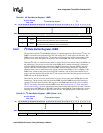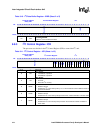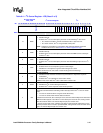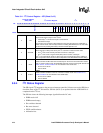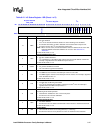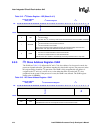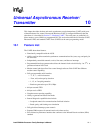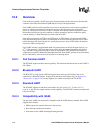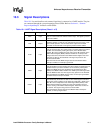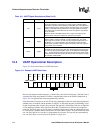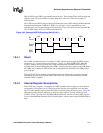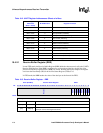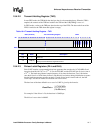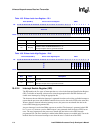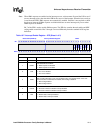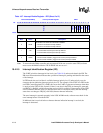
Intel® PXA26x Processor Family Developer’s Manual 10-3
Universal Asynchronous Receiver/Transmitter
10.3 Signal Descriptions
Table 10-1 lists and describes each external signal that is connected to a UART module. The pins
are connected through the system integration unit to GPIOs. Refer to Section 4.1, “General-
Purpose Input/Output” for details on the GPIOs.
Table 10-1. UART Signal Descriptions (Sheet 1 of 2)
Name Type Description
RXD Input
SERIAL INPUT – Serial data input to the receive shift register. In infrared
mode, it is connected to the infrared receiver input. This signal is present
on all three UARTs.
TXD Output
SERIAL OUTPUT – Serial data output to the communications link-
peripheral, modem, or data set. The TXD signal is set to the logic 1 state
upon a Reset operation. It is connected to the output of the infrared
transmitter in infrared mode. This signal is present all three UARTs.
nCTS Input
CLEAR TO SEND – When low, indicates that the modem or data set is
ready to exchange data. The nCTS signal is a modem status input and its
condition can be tested by reading bit 4 (CTS) of the Modem Status
Register. Bit 4 is the complement of the nCTS signal. Bit 0 (DCTS) of the
Modem Status Register (MSR) indicates whether the nCTS input has
changed state since the last time the Modem Status Register was read.
nCTS has no effect on the transmitter. This signal is present on the
FFUART and BTUART.
When the CTS bit of the MSR changes state and the Modem Status
interrupt is enabled, an interrupt is generated.
nDSR Input
DATA SET READY – When low, indicates that the modem or data set is
ready to establish a communications link with a UART. The nDSR signal is
a Modem Status input and its condition can be tested by reading Bit 5
(DSR) of the MSR. Bit 5 is the complement of the nDSR signal. Bit 1
(DDSR) of the MSR indicates whether the nDSR input has changed state
since the MSR was last read. This signal is only present on the FFUART.
When the DSR bit of the MSR changes state, an interrupt is generated if
the Modem Status interrupt is enabled.
nDCD Input
DATA CARRIER DETECT – When low, indicates that the data carrier has
been detected by the modem or data set. The nDCD signal is a modem
status input and its condition can be tested by reading Bit 7 (DCD) of the
MSR. Bit 7 is the complement of the nDCD signal. Bit 3 (DDCD) of the
MSR indicates whether the nDCD input has changed state since the
previous reading of the Modem Status Register. nDCD has no effect on
the receiver. This signal is only present on the FFUART.
When the DCD bit changes state and the Modem Status interrupt is
enabled, an interrupt is generated.



